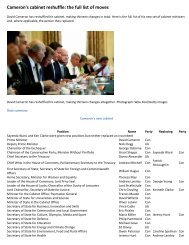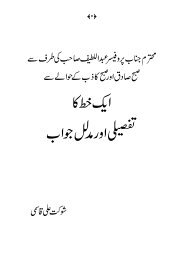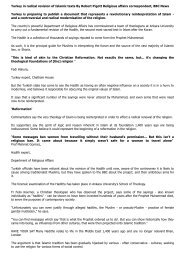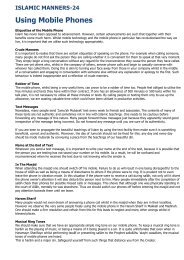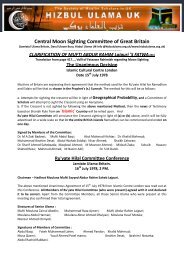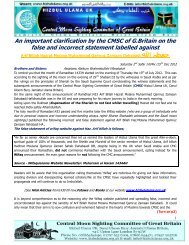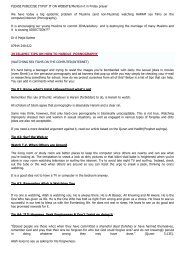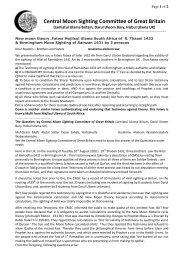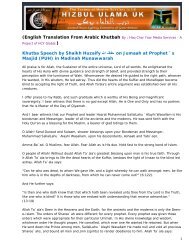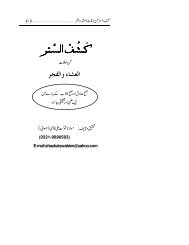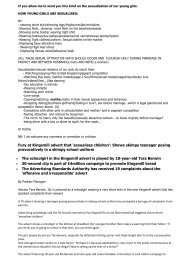Why our fasting times and timetable are not wrong - Hizbul Ulama UK
Why our fasting times and timetable are not wrong - Hizbul Ulama UK
Why our fasting times and timetable are not wrong - Hizbul Ulama UK
Create successful ePaper yourself
Turn your PDF publications into a flip-book with our unique Google optimized e-Paper software.
In the name of Allah, the beneficent, the merciful<br />
Central Moon Sighting Committee<br />
of Great Britain<br />
(Jamiatul <strong>Ulama</strong> Britain, Darul Uloom Bury, <strong>Hizbul</strong> <strong>Ulama</strong> <strong>UK</strong>)<br />
Info@hizbululama.org.uk / www.hizbululama.org.uk<br />
<strong>Why</strong> <strong>our</strong> <strong>fasting</strong> <strong>times</strong> <strong>and</strong> <strong>timetable</strong><br />
<strong>are</strong> <strong>not</strong> <strong>wrong</strong><br />
Word of Advice<br />
The recently circulated pamphlet “Y<strong>our</strong> <strong>fasting</strong> <strong>times</strong> <strong>are</strong> <strong>wrong</strong>” is a misguided attempt to frighten Muslims<br />
who follow the <strong>timetable</strong> of <strong>Hizbul</strong> <strong>Ulama</strong>, Jamiyat <strong>Ulama</strong> <strong>and</strong> Markazi Jamiyat <strong>Ulama</strong>. Do <strong>not</strong> be influenced<br />
by this. It is <strong>not</strong> the way <strong>our</strong> Akabireen has taught us to behave when there <strong>are</strong> differences in opinion <strong>and</strong> it is<br />
totally impermissible to cause dissension <strong>and</strong> fitnah in this way. Their main objection is that the <strong>timetable</strong><br />
does <strong>not</strong> match the observations but they fail to point out that the <strong>times</strong> <strong>are</strong> within sh<strong>are</strong>e hoodud. This article<br />
will provide details about the validity of the <strong>timetable</strong> <strong>and</strong> ensure you have confidence in the <strong>timetable</strong> of the<br />
<strong>Ulama</strong>. Note very c<strong>are</strong>fully that the <strong>Ulama</strong> who carried out the Mushahadah were highly knowledgeable <strong>and</strong><br />
well respected <strong>and</strong> knew what they were doing. It is therefore sl<strong>and</strong>erous <strong>and</strong> tantamount to Buhtan for the<br />
critics to cast aspersions on those <strong>Ulama</strong> who gave up their valuable time <strong>and</strong> sacrificed their sleep, gave up<br />
other commitments <strong>and</strong> braved harsh <strong>UK</strong> weather conditions to try <strong>and</strong> bring unity in <strong>UK</strong> <strong>timetable</strong>s.<br />
Background to the <strong>Hizbul</strong> <strong>Ulama</strong> <strong>UK</strong> <strong>timetable</strong><br />
There is at the moment a fierce un-Islamic onslaught by a select few on the <strong>Hizbul</strong> <strong>Ulama</strong><br />
<strong>UK</strong>/Jamiyat <strong>Ulama</strong> <strong>and</strong> Markazi Jamiyat <strong>Ulama</strong> Bartaniya backed <strong>timetable</strong> (referred to<br />
hereafter as HU/JU/MJU or collectively as “the Jamaats”). In recent days a pamphlet was<br />
distributed titled “Y<strong>our</strong> <strong>fasting</strong> <strong>times</strong> <strong>are</strong> <strong>wrong</strong>” trying to frighten people. The pamphlet tries<br />
to show that the <strong>Hizbul</strong> <strong>Ulama</strong> <strong>UK</strong> <strong>timetable</strong>s <strong>are</strong> <strong>wrong</strong>. This is the latest tactic in a series of<br />
fierce unprecedented attacks on the <strong>timetable</strong> <strong>and</strong> the scholars of the Jamaats personally.<br />
The recent spate of attacks appear to have been triggered by an event in London which saw<br />
this <strong>timetable</strong>, just before Ramadan, accepted by key London Umbrella Organisations <strong>and</strong><br />
Masajid comprising at least 36 organisations including the Islamic Cultural Centre & London<br />
Central Mosque (ICC), Mayfair Islamic Centre, East London Mosque, Muslim Welf<strong>are</strong> House,<br />
Al Manaar – The Muslim Cultural Heritage Centre, Masjid Al Tawhid & Islamic Sharia<br />
Council, Al Muntada al Islami Trust, London Muslim Forum (25 members) <strong>and</strong> many others.<br />
This decision came on the back of an initial meeting hosted by ICC at Regents Park, London,<br />
on Thursday 25 th March 2010. After no less than a year of deliberation <strong>and</strong> research, an Ijma<br />
(consensus) was reached by these organisations to adopt this <strong>timetable</strong> just before Ramadan<br />
1432 (July 2011). This historic decision in London comes after 23 years since the <strong>Ulama</strong><br />
undertook the task of unifying the <strong>timetable</strong> for the United Kingdom. It is a hugely positive<br />
step <strong>not</strong> just for London but for the <strong>UK</strong> as whole.<br />
F<strong>our</strong> decades ago in the <strong>UK</strong> there were a range of <strong>timetable</strong>s ranging from 12-18 degrees (<strong>and</strong><br />
other fixed methods) to perform Fajar <strong>and</strong> Isha. There was confusion all round <strong>and</strong> fierce<br />
disagreements were common amongst the Muslims. Arguments took place repeatedly within<br />
the community <strong>and</strong> many people were becoming fed-up <strong>and</strong> getting more <strong>and</strong> more agitated<br />
1
until one day hope arrived. After considerable pressure from key people <strong>and</strong> committees of<br />
Masajids on the Scholars, the Scholars resolved to sort out this issue in the same way as they<br />
had resolved the Moon sighting issue previously at a mass meeting of the <strong>Ulama</strong> at Darul<br />
Uloom, Bury.<br />
The <strong>Ulama</strong> realised that the only way to resolve this issue was by carrying out a mushahadah.<br />
The spark for this mushahadah was ignited just over 80 years ago by Hakimul Ummat Hazrat<br />
Thanvi RA when he urged a questioner from Scotl<strong>and</strong> to conduct a mushahadah. But how do<br />
you carry out mushahadah in a country like the <strong>UK</strong>? The questioner from Scotl<strong>and</strong> had<br />
responded to Hazrat by saying it was <strong>not</strong> possible to carry out a mushahadah in the <strong>UK</strong>. Lots<br />
of questions came to the mind of the <strong>Ulama</strong>. Weather conditions, time commitment, whether<br />
or <strong>not</strong> it would be possible to observe etc presented as major challenges. A group of <strong>Ulama</strong><br />
under the supervision of HU, resolved to do what they can to solve this problem <strong>and</strong> took it<br />
upon themselves to unite the Muslims of the <strong>UK</strong> on Fajar <strong>and</strong> Isha <strong>times</strong>.<br />
A group of <strong>Ulama</strong> c<strong>our</strong>ageously volunteered <strong>and</strong> began a year long effort to complete a<br />
mushahadah which was to begin in September 1987. After three months of Mushahadah, HU<br />
referred the issue of differences they were finding in the time length between the mushahadah<br />
<strong>and</strong> degree <strong>times</strong> to the Muftiyane Kiram of the Indian Sub Continent. The responses from<br />
Muftiyane Kiram were enc<strong>our</strong>aging <strong>and</strong> did <strong>not</strong> result in the <strong>Ulama</strong> ab<strong>and</strong>oning the effort <strong>and</strong><br />
going back to degrees.<br />
After a full seven months of effort, braving of weather conditions, <strong>and</strong> setting aside other<br />
responsibilities, a meeting was held in Masjid Anisul Islam, Troy Street, Blackburn, United<br />
Kingdom, on Saturday 15 th Shaban 1408 (2 nd April 1988). The meeting was attended by<br />
countless <strong>Ulama</strong> from all over the Country who were all looking forward to this pressing issue<br />
to be resolved. This joint meeting between the <strong>Ulama</strong> of the Jamaats (HU, JU <strong>and</strong> MJU) was<br />
conducted under a joint Imarat of Molana Musa Karmadi, convener of HU, <strong>and</strong> Molana<br />
Ubaidurrahman Camelpuri RA, Executive Member of JU.<br />
Present at this gathering were the Mushahedeen (observers) <strong>and</strong> many eminent personalities<br />
including Molana Ahmed P<strong>and</strong>or (Chair-JU) Molana Mohamad Hassan Tai Chair-MJU,<br />
Molana Lutfurrahman RA VChair-MJU, Molana Musa Qasmi, Molana Ismail Makoria Chair-<br />
HU, Molana Ismail Bhuta Principal-Madrastul Banat, Molana Fazle Haq Wadi, Principal,<br />
Madrasah Banat, Lancaster, Mufti Mustupha Principal-Darul Uloom London, Molana Aslam<br />
Zahid, Mufti Abdus Samad Principal -Jamiatul Ilm Walhuda, Molana Ahmed Sidat sab, well<br />
known community leader <strong>and</strong> Chairman of Jamea Masjid Blackburn, <strong>and</strong> many others too<br />
numerous to mention.<br />
At this meeting the <strong>Ulama</strong> who carried out the Mushahadah disclosed what they had observed<br />
to the point that it was <strong>not</strong> left as fait accompli that they had observed a particular<br />
phenomenon. It was left to the meeting to decide what was observed e.g. whether the<br />
observations were that of Subha Sadiq, Subha Kadhib or some other phenomenon.<br />
The following provides an outline of what was observed through the Mushahadat during the<br />
first seven months (September-March):<br />
1. The first light of morning which began as a broad b<strong>and</strong> of light on the horizon from its<br />
beginning <strong>and</strong> spread very quickly at the breadth of the horizon (reaching the condition of<br />
Tabayyun within a few minutes), <strong>and</strong> continuing to increase in broadness <strong>and</strong> intensity until<br />
sunrise<br />
2
2. During the seven months we did <strong>not</strong> see any light which resembled the description of Subha<br />
Kadhib i.e. light on the length of the horizon appearing like the tail of a Wolf or in the shape of<br />
a pyramid, <strong>and</strong> then diminishing slowly <strong>and</strong> then completely disappearing before the onset of<br />
Subha Sadiq<br />
3. We observed, at the western horizon, the end of the sun’s red afterglow after sunset<br />
followed by the complete disappearance of the whiteness in the sky<br />
After a thorough examination by the <strong>Ulama</strong> lasting about three h<strong>our</strong>s, the <strong>Ulama</strong> determined<br />
from the description given what phenomena were Subha Kadhib, Subha Sadiq, Shafaqe<br />
Ahmar, Shafaqe Abyadh etc.<br />
The following resolutions were then agreed:<br />
1. That in the light of the numerous <strong>and</strong> consistent Fataawa of Muftiyane Kiram which were<br />
received after the first three months of Mushahadah, that Mushahadah is the original basis of<br />
determining prayer <strong>times</strong>, <strong>and</strong> that against this background, relying on the accuracy of<br />
observatory <strong>times</strong> was incorrect.<br />
2. It was unanimously resolved that Mushahadah be completed for the rest of the remaining<br />
five months after which a<strong>not</strong>her meeting of the <strong>Ulama</strong> be held to consider the remaining<br />
results.<br />
3. That, in the meantime, the Muslims of the <strong>UK</strong> prep<strong>are</strong> forthwith their <strong>timetable</strong>s according<br />
to the chart prep<strong>are</strong>d based on the Mushahadah of seven months.<br />
4. That for the remaining five months <strong>not</strong> covered by Mushahadah, the prayers <strong>are</strong> fixed on<br />
the basis of Takdir, but only for a temporary period. When the Mushahadah of the remaining<br />
five months be completed, a comprehensive chart be prep<strong>are</strong>d based on observance of Subha<br />
Sadiq <strong>and</strong> Isha for a complete year.<br />
5. It was also resolved that once the full year Mushahadah is completed that any unobserved<br />
days due to bad weather conditions be filled by the method of Takdir as is permitted by<br />
Shariah (Imdadul Fatawa Vol 1 Page 98)<br />
Likewise, the <strong>Ulama</strong> continued their Mushahadah <strong>and</strong> after completing this most noble project<br />
on behalf of the Muslims of the <strong>UK</strong>, held a<strong>not</strong>her meeting on Monday 24 JamaDilAwwal 1409<br />
Hijri (2 January 1989).<br />
At this meeting details of the Mushahadah of the additional five months (April-August) were<br />
given, as follows. Where differences existed between the two sets of Mushahadat these were<br />
highlighted:<br />
1. On 2 nd <strong>and</strong> 6 th May a very narrow light was observed on the length of the sky which<br />
resembled a pyramid. This light then died down slowly <strong>and</strong> merged with the First Light of<br />
morning<br />
2. The gaps between the Subha Sadiq <strong>times</strong> <strong>and</strong> sunrise; <strong>and</strong> between sunset <strong>and</strong> end of the<br />
red afterglow (shafaqe ahmar) were much wider during the latter five months than observed<br />
3
during the first seven months Mushahadat. It appe<strong>are</strong>d there were differences between the<br />
Mushahadat carried out in winter <strong>and</strong> the Mushahadat carried out in the summer months.<br />
3. A unique phenomenon was observed from the end of May until 6 th of June. An apparition<br />
in the form of an arc was <strong>not</strong>iced. It appe<strong>are</strong>d to be ‘vap<strong>our</strong>y’ in appearance <strong>and</strong> was <strong>not</strong><br />
visually as distinct to enable us to confidently describe it as a light phenomenon. The “arc”<br />
appe<strong>are</strong>d to slowly inch towards the east i.e. at the location of sunrise, along the edge of the<br />
earth <strong>and</strong> sky. As First Light appe<strong>are</strong>d, this image disappe<strong>are</strong>d.<br />
4. In the middle of June we observed the disappearance of the red afterglow (shafaqe ahmar)<br />
but the whiteness in the sky remained throughout the night becoming brighter <strong>and</strong> covering<br />
an extensive <strong>are</strong>a of the sky. Subha Sadiq was <strong>not</strong> possible to observe as it seemed that<br />
conditions of Shafaq did <strong>not</strong> end <strong>and</strong> merged with the light of dawn.<br />
5. During May <strong>and</strong> June the First Light of morning took incredibly longer to spread along the<br />
horizon than observed before. Instead of reaching Tabayyun in only a few minutes as<br />
observed during previous months, the condition of Tabayyun took much longer averaging<br />
from 20 minutes to over one h<strong>our</strong> <strong>and</strong> fifteen minutes, during these two months.<br />
It was agreed at this meeting to use First Light <strong>times</strong> generally for Subha Sadiq but to use<br />
Tabayyun <strong>times</strong> (spreading of light) during summer months. It was also agreed to use Shafaqe<br />
Abyadh (disappearance of whiteness) for Isha generally but to use Shafaqe Ahmer<br />
(disappearance of red after glow) during summer due to haraj (hardship). Phasing of <strong>times</strong> to<br />
get to one method to the other was agreed for both Subha <strong>and</strong> Isha. Accordingly, a chart based<br />
on the agreement of the <strong>Ulama</strong> was distributed to <strong>UK</strong> Masajids. This is how unity was reached<br />
on the issue that divided the Muslim community in Britain for far too long.<br />
Sadly, the unity was later broken by people who preferred to base their prayer timings on<br />
Degree <strong>times</strong> provided by the Observatory. Some Masajid chose the easy route by adopting 15<br />
Degrees whilst others adopted 18 Degrees believing that 15 or 18 degrees represented the<br />
correct timings. There were also those who held Isha one h<strong>our</strong> after Maghrib all year round,<br />
whilst some held Isha one h<strong>our</strong> after Maghrib only during the summer. There were those who<br />
followed degrees <strong>and</strong> other methods simply for the sake of convenience, as the internet made<br />
it so easy to produce instant computations of Salat <strong>times</strong> for their own locality.<br />
Please <strong>not</strong>e that the group of <strong>Ulama</strong> who carried out the Mushahadah in Blackburn,<br />
Lancashire, <strong>UK</strong>, did so during a complete year <strong>and</strong> did <strong>not</strong> set out to test Degree <strong>times</strong>,<br />
thereby disregarding the <strong>times</strong> provided by the Observatory <strong>and</strong> starting from a clean sheet.<br />
They were, therefore, <strong>not</strong> psychologically swayed by already given Observatory <strong>times</strong>. Many<br />
other Mushahadah have tended to determine the level of solar depression level to use for the<br />
prayer <strong>times</strong> <strong>and</strong> the <strong>Ulama</strong> have made limited test observations at the <strong>times</strong> provided by the<br />
Observatory. Our observations, therefore, unlike the observations of others did <strong>not</strong> seek to<br />
confirm or reject any of the Observatory degree <strong>times</strong> but to provide prayer timings based<br />
purely on what was observed.<br />
This <strong>timetable</strong>, based on the observations in Blackburn, from September 1987 to August<br />
1988 yielded 98 successful observations, <strong>not</strong> 11 as some people <strong>are</strong> claiming. These consist<br />
of 34 for Subha Sadiq (27 First Light <strong>and</strong> 7 Tabayyun, the latter limited to summer), 62 Isha<br />
(22 Shafaqe Ahmer, <strong>and</strong> 40 Shafaqe Abyadh). The observations were made available at the<br />
4
gathering of the <strong>Ulama</strong> <strong>and</strong> published despite what critics say that only 11 observations<br />
were published.<br />
These observations were used to construct a <strong>timetable</strong> for a full year which can be applied to<br />
all parts of the <strong>UK</strong> using the gaps in twilight length determined by the observations. Solar<br />
depression angles too determine twilight length <strong>and</strong>, likewise, the twilight length determined<br />
from actual mushahadah were used to prep<strong>are</strong> <strong>timetable</strong>s in other towns <strong>and</strong> cities.<br />
The Mushahadah <strong>and</strong> the construction of the <strong>timetable</strong> were based on countless Fatawa from<br />
Muftiyane Kiram from the Indian Sub Continent following direct correspondence during the<br />
mushahadah. These <strong>are</strong> summarised in the Urdu book, Bartaniya Me Isha Ka Sahih Waqt <strong>and</strong><br />
some in the English book, Fajar <strong>and</strong> Isha <strong>and</strong> Twilight, available on the <strong>Hizbul</strong> <strong>Ulama</strong><br />
website.<br />
There have also been fatwa issued post observations such as the Fatwa by Mufti Azam,<br />
Pakistan, Hazrat Mufti Rafi Uthmani Sab, MZT who has expressly drawn attention to the<br />
supremacy of mushahadah over degree <strong>times</strong> in his book Nawdirul Fiqh. Mufti Sahib says that<br />
even if observations were carried out for a few days only <strong>and</strong> a gap in twilight length<br />
determined from these limited observations, the <strong>timetable</strong> will be permissible for <strong>not</strong> only<br />
those who have confidence in the observations but even those who hold some doubt about<br />
the observations carried out. Mufti Sab assumed the observations were carried out for only a<br />
few days yet rules it permissible. The questioner did <strong>not</strong> provide full details about the<br />
extensive observations as outlined above <strong>and</strong> Hazrat therefore assumed a few observations<br />
were carried out <strong>and</strong> a fixed time length was determined for twilight. Imagine how Hazrat<br />
would have responded if he knew how many observations were successfully completed!<br />
(Click here for the article, “which <strong>timetable</strong> should you follow?”)<br />
Some Fatwas regarding Mushahadah<br />
1. Mufti Abdullah Kawi, Darul Uloom Bharuch, India, has ruled that the basis of determining<br />
Salat <strong>times</strong> is on Mushahadah according to Sh<strong>are</strong>e guidance <strong>and</strong> boundaries. The<br />
determination of Salat <strong>times</strong> <strong>are</strong> <strong>not</strong> based on scientific findings. Where Mushahadah confirms<br />
the <strong>times</strong> provided through scientific findings then it will be permissible to follow these <strong>times</strong>.<br />
However, where there <strong>are</strong> differences between these two, then Mushahadah will take<br />
precedence <strong>and</strong> the <strong>times</strong> determined through scientific methods will have to be ignored.<br />
2. Mufti Abdusshakoor Tirmizi, Madrassah Arabiya Haqaniyah, Sargodha, Pakistan, said,<br />
“The knowledge of Mushahadah is more reliable <strong>and</strong> in using Hisabat there is an element of<br />
doubt”.<br />
3. Mufti Mohammad Farid, Darul Uloom Haqaniyah, Pakistan, said, “Every month you<br />
should carry out a Mushahadah on two or three days. Leave aside the use of degrees as even<br />
in Indo-Pak it has been shown to contradict Mushahadah”.<br />
5
4. Mufti Shafi’ RA, in answer to a question about the use of degrees replied that “it is<br />
permissible to use degrees provided that the <strong>times</strong> have been verified by Mushahadah”.<br />
5. Hazrat Molana Ashraf Ali Thanvi RA ruled that it is <strong>not</strong> possible to determine Subha Sadiq<br />
without carrying out Mushahadah (Bawadirun Nawadir, Assa’at Lit’ta’at, Page 429)<br />
6. Mufti Mohammad Amin, Mazahirul Uloom, Sahranpur, India, states that “Salat <strong>times</strong> <strong>are</strong><br />
related to Mushahadat. Mushahadah will be given precedence. Mushahadah is the original<br />
basis of determining Salat <strong>times</strong> <strong>and</strong> these will be taken as the correct <strong>times</strong>. In the Hadith<br />
Mushahadah is the method enshrined in the Shariah <strong>and</strong> there is no mention of degrees <strong>and</strong><br />
no other formula for approximation. Shariah basis the determination of Salat <strong>times</strong> on the<br />
simplicity contained within nature. Therefore, in the determination of Shafaq <strong>and</strong> Subha it is<br />
<strong>not</strong> necessary to go in the middle of a mountain or board an aeroplane or a rocket or to go in<br />
the middle of the ocean to find out the precise <strong>times</strong>. But, where there is a populace one may<br />
carry out a Mushahadah with plainness <strong>and</strong> simplicity <strong>and</strong> according to the guidelines in<br />
Shariah. This will be sufficient”.<br />
What the pious <strong>Ulama</strong> say about differences<br />
It is totally inappropriate for this group to force their own <strong>timetable</strong>s down people’s throats<br />
<strong>and</strong> to condemn other <strong>timetable</strong>s. The language they have used in emails have been highly<br />
charged <strong>and</strong> full of despair <strong>and</strong> frustration. Do they think Allah Subhanahu Wata Ala will <strong>not</strong><br />
accept the <strong>fasting</strong> <strong>and</strong> prayer of sincere Muslims because they say so? Do they have a<br />
monopoly on the truth? The truth is that they do <strong>not</strong> have all the answers <strong>and</strong> <strong>are</strong> <strong>not</strong><br />
permitted by Shariah to do what they <strong>are</strong> doing.<br />
Hazrat Mufti Mahmudul Hasan Gangohi RA- One of <strong>our</strong> greatest Muftis’ <strong>and</strong> buzrug<br />
of the century ruled about differences of opinion in <strong>timetable</strong>s many years go. The declaration<br />
by Hazrat Gangohi RA in 1983 at Jame Masjid, Howard Street, Bradford, circulated by the<br />
critics, suggesting an agreement on adopting 18 degrees, it will be remembered, was revoked<br />
by Hazrat <strong>and</strong> Hazrat issued a<strong>not</strong>her Fatwa at the same time, which Molana Qasmi has used<br />
in his book ruling that any method one adopts will be permitted. This is also evidenced by a<br />
pamphlet published at the time by Jamiatul <strong>Ulama</strong> Britain <strong>and</strong> by Hazrat Maulana Ismail<br />
Manubari sahib personally the Muhtamim of Darul Uloom Bharuch.<br />
Note also that the gathering in Bradford took place in 1983 <strong>and</strong> the <strong>Hizbul</strong> <strong>Ulama</strong> observations<br />
were carried out much later, in 1987/88 <strong>and</strong> final agreement by the <strong>Ulama</strong> reached in 1989, yet<br />
the article “y<strong>our</strong> <strong>fasting</strong> <strong>times</strong> <strong>are</strong> <strong>wrong</strong>” gives the impression that Hazrat Mufti Sab did <strong>not</strong><br />
“give leeway to follow the <strong>Hizbul</strong> <strong>Ulama</strong> <strong>timetable</strong>”. This is highly deceptive as at the time of<br />
Hazrat’s visit the mushahadah had <strong>not</strong> even taken place.<br />
It was at this very meeting which resulted in the 70 year old “spark” of mushahadah ignited<br />
by Hazrat Thanvi RA, to turn into a flame in the hearts of some <strong>Ulama</strong>.<br />
(Click here for references <strong>and</strong> evidence)<br />
Mufti Azam Hazrat Maulana Rafi’ Uthmani Sahib- One of <strong>our</strong> top Scholars <strong>and</strong> the<br />
Gr<strong>and</strong> Mufti in Pakistan also permits the adoption of different methods including 18 degrees<br />
6
(for Fasting only, as Hazrat advocates praying Fajar much later to ensure Fajar time has<br />
properly entered) as well as the Mushahadah <strong>timetable</strong>. In fact, as mentioned above already,<br />
despite believing, from the way the question from Leicester was posed, that the Mushahadah<br />
was only for a few days which determined a fixed gap of 1 h<strong>our</strong> <strong>and</strong> 35 minutes in twilight<br />
length, Hazrat deems this permissible. He goes much further <strong>and</strong> says it will be permissible<br />
for even those who have doubt in the mushahadah! Alhamdolillah!<br />
Hazrat refers to the decision of the <strong>Ulama</strong> in Blackburn, as tantamount to a Fatwa in his book<br />
Nawdirul Fiqh. These <strong>are</strong> the wise Scholars who do <strong>not</strong> condemn differences but allow<br />
flexibility <strong>and</strong> ease. Hazrat rules 18 degrees as “Zanni”, <strong>not</strong> “Qat’i” in his book Nawdirul Fiqh<br />
<strong>and</strong> also rules “Zanni” <strong>not</strong> “qat’i” the fact that twilight length for Isha <strong>and</strong> Fajar <strong>are</strong> the same”.<br />
More on this later.<br />
Maintaining Islamic manners at all <strong>times</strong><br />
In terms of criticising other methods such as is going on by the ferocious few look at what<br />
Sheikh Haitham al Haddad has said:<br />
“Having written this <strong>and</strong> respectfully disagreeing with others, I urge all to maintain the<br />
Islamic etiquette of differing. We should <strong>not</strong> allow such differences to disunite us or place<br />
enmity in <strong>our</strong> hearts. May Allah keep us united, keep <strong>our</strong> hearts pure, <strong>and</strong> forgive <strong>our</strong><br />
shortcomings”.<br />
What I have found recently goes against the spirit of this wonderful advice <strong>and</strong> the ferocious<br />
few have hurled abuse on the internet <strong>and</strong> have made repeated sl<strong>and</strong>erous comment<br />
personalising this debate to such an extent that a great deal of frustration <strong>and</strong> despair is<br />
exhibited by them. It is as though the few have taken on the burden of the whole world <strong>and</strong><br />
unless they win their argument the world will be lost <strong>and</strong> qiyamah will come. May Allaah give<br />
them hidayah <strong>and</strong> forgive them for their error. Aameen.<br />
I have said previously <strong>and</strong> as already mentioned above that where there <strong>are</strong> genuine fiqhi<br />
differences no one should say the other is <strong>wrong</strong>, let alone hurl abuse <strong>and</strong> personal insults like<br />
what they <strong>are</strong> doing at the moment.<br />
What these critics <strong>are</strong> doing is going against Islamic etiquette <strong>and</strong> those who have seen their<br />
emails have witnessed hatred in their words. Again may Allah give them hidayah <strong>and</strong> forgive<br />
their sins. Ameen.<br />
What <strong>are</strong> they objecting to?<br />
1. <strong>Hizbul</strong> <strong>Ulama</strong> <strong>timetable</strong> does <strong>not</strong> follow their own observed<br />
<strong>times</strong>- The main point of criticism by these people concerns the construction of the <strong>timetable</strong>.<br />
The way the <strong>timetable</strong> was constructed <strong>and</strong> agreed by the meeting of the <strong>Ulama</strong> affiliated to<br />
<strong>Hizbul</strong> <strong>Ulama</strong>, Jamiyat <strong>Ulama</strong> <strong>and</strong> Markazi Jamiyat <strong>Ulama</strong> at Masjid Anisul Islam, Troy Street,<br />
Blackburn, is to perform Isha on Shafaqe Abyadh (disappearance of the whiteness) except in<br />
summer months due to haraj (hardship) when Shafaqe Ahmer would be used. The <strong>times</strong><br />
would be phased to get from one to the other.<br />
7
Likewise for Fajar, the <strong>times</strong> observed for First Light would be used except for summer when<br />
the <strong>times</strong> observed for Tabayyun (spreading of light along the horizon) would be used. Again<br />
<strong>times</strong> will need to be phased to get from one to the other.<br />
This method results in some <strong>times</strong> that <strong>are</strong> “in between” <strong>times</strong>. This is what the critics object<br />
to. However, as this method necessitates phasing to avoid “jumping” <strong>times</strong> it is perfectly valid<br />
particularly as the <strong>times</strong> <strong>are</strong> within “hudoode shariah”.<br />
This method is very similar to the phasing used for <strong>timetable</strong>s following 18 degrees which the<br />
critics adopt. The latest time for Isha based on 18 degrees is about 12.30 am (yes 12.30am!) yet<br />
no Masjid performs Isha after 12.30am, <strong>not</strong> even the Masjid the critics <strong>are</strong> controlling.<br />
By their own st<strong>and</strong>ards what they should be doing is to perform Isha after 12.30am until<br />
“twilight persists” <strong>and</strong> then move onto fixed <strong>times</strong> but everyone knows this is <strong>not</strong> what is<br />
practised. They too use the phasing method to get to the fixed <strong>times</strong> <strong>and</strong> their <strong>times</strong> too do <strong>not</strong><br />
match 18 degrees all year round.<br />
This is the observatory computed 18 degree <strong>timetable</strong> for London for the month of May only<br />
by way of illustration, which you can comp<strong>are</strong> with the Masjid <strong>timetable</strong> of those who claim to<br />
follow 18 degrees. Just look at the time of Isha on this chart. “Twilight persist time” does <strong>not</strong><br />
begin until the end of May yet they start to adjust their <strong>times</strong> from March <strong>and</strong> continue to do<br />
this until September.<br />
London May <strong>timetable</strong>, 18 degrees Subha/18 degrees Shafaq<br />
Subha Sunrise Noon Asr1 Asr2 Sunset Isha<br />
2011 5 1 03 05 05 33 12 58 17 01 18 05 20 23 22 53<br />
2011 5 2 03 02 05 32 12 58 17 01 18 06 20 25 22 56<br />
2011 5 3 02 58 05 30 12 58 17 02 18 07 20 27 23 00<br />
2011 5 4 02 55 05 28 12 58 17 03 18 08 20 28 23 03<br />
2011 5 5 02 51 05 26 12 57 17 03 18 09 20 30 23 07<br />
2011 5 6 02 47 05 24 12 57 17 04 18 10 20 31 23 11<br />
2011 5 7 02 43 05 23 12 57 17 04 18 11 20 33 23 14<br />
2011 5 8 02 39 05 21 12 57 17 05 18 12 20 35 23 18<br />
2011 5 9 02 35 05 19 12 57 17 06 18 12 20 36 23 22<br />
2011 5 10 02 31 05 17 12 57 17 06 18 13 20 38 23 26<br />
2011 5 11 02 27 05 16 12 57 17 07 18 14 20 39 23 31<br />
2011 5 12 02 23 05 14 12 57 17 08 18 15 20 41 23 35<br />
2011 5 13 02 19 05 13 12 57 17 08 18 16 20 42 23 40<br />
2011 5 14 02 14 05 11 12 57 17 09 18 17 20 44 23 44<br />
2011 5 15 02 09 05 10 12 57 17 09 18 18 20 46 23 49<br />
2011 5 16 02 04 05 08 12 57 17 10 18 19 20 47 23 55<br />
2011 5 17 01 59 05 07 12 57 17 10 18 20 20 48 24 00<br />
2011 5 18 01 53 05 05 12 57 17 11 18 21 20 50 24 06<br />
2011 5 19 01 47 05 04 12 57 17 12 18 21 20 51 24 13<br />
2011 5 20 01 41 05 02 12 57 17 12 18 22 20 53 24 21<br />
8
2011 5 21 01 33 05 01 12 57 17 13 18 23 20 54 24 31<br />
2011 5 22 01 23 05 00 12 57 17 13 18 24 20 56 24 48<br />
2011 5 23 01 07 04 59 12 57 17 14 18 25 20 57 ** **<br />
Regarding the <strong>Hizbul</strong> <strong>Ulama</strong> <strong>timetable</strong> they give examples of two dates where there <strong>are</strong><br />
alleged discrepancies but these <strong>are</strong> within the sh<strong>are</strong>e hoodud <strong>and</strong> therefore permissible as one<br />
may go on eating up to Tabayyun conditions as did some Sahaba Kiram RA Ajmaeen.<br />
DATE First Light gap Tabayyun gap Gap in<br />
<strong>timetable</strong><br />
Within Sh<strong>are</strong>e<br />
Hoodud?<br />
May 21 2hr 22m 1hr 32m 1hr 51m YES<br />
Aug 16 1hr 54m 1hr 24m 1hr 40m YES<br />
2. First Light <strong>and</strong> Tabayyun- With regard to the issue of First Light vs Tabayyun,<br />
Mufti Saeed Ahmed Palanpuri with the support of Mufti Mohammad Amin <strong>and</strong> Mufti Abdur-<br />
Rauf says that there is disagreement in Hanafi Fiqh on whether the beginning of Fast is from<br />
Faj<strong>are</strong> Haqiqi or from its Tabayyun (i.e. when the light has spread along the horizon). Whilst<br />
the beginning of the Fast at First Light is the safer of the two, the time of Tabayyun allows ease<br />
<strong>and</strong> is permissible. This ruling is supported by Mufti Saeed Ahmed who referred to Hazrat<br />
Molana Binori’s Marifuss Sunan, Volume 5, Page 323, which itself is based on Fatawa<br />
Hindiyah, the Fatawa Alamghiri, which uses Halwani, Al Muhiti <strong>and</strong> Khazanatul Fatawa in<br />
support of this ruling. As mentioned we have used First Light observed time for most months<br />
except summer where we have used Tabayyun <strong>times</strong>. Phasing is used <strong>and</strong> although the<br />
phasing results in “in between” <strong>times</strong>, this is permissible as it is within “Sh<strong>are</strong>e Hoodud” <strong>and</strong><br />
it was <strong>not</strong> something that a group of <strong>Ulama</strong> thrusted onto the masses without Shoora but<br />
properly proposed, debated <strong>and</strong> agreed at the gathering of the <strong>Ulama</strong> <strong>and</strong> Muftiyane Kiram in<br />
Blackburn.<br />
Note that there is leeway (gunjaish) in shariah for Suhur but <strong>not</strong> for Fajar. If Fajar is prayed<br />
before its time it will <strong>not</strong> be accepted but Allah Subhanahu Tala has placed flexibility in the<br />
time of suhur as is seen from the practise of the Sahaba Kiram RA Ajmaeen.<br />
Dr Khalid Shaukat says:<br />
“The variation you may see is <strong>not</strong> an alarming variation. Remember, in the time of Prophet<br />
SallallahuAlaihiWasallam, there were no watches. Much more variations were in<br />
practice…..….. Quran mentions Fajar time as when you can differentiate a black thread from a<br />
white thread. Some Sahabi (RA) was observed to physically take two threads <strong>and</strong> trying to see<br />
them; the Prophet SallallahuAlaihiWasallam clarified to him that this is <strong>not</strong> the intent of<br />
Shariah. It is when the very faint light of morning begins to spread horizontally in the<br />
darkness of night. This phenomenon is <strong>not</strong> very strictly quantifiable”.<br />
(Click for article “Subha Sadiq <strong>and</strong> its starting time” by Maulana, Dr A.Z.M<br />
Sayeed Chowdhury, Glasgow University)<br />
3. Rejection of Mushahadah by Fatwa- They say, ‘senior Muftiyane Kiram in the<br />
<strong>UK</strong> <strong>and</strong> abroad have condemned it as unreliable <strong>and</strong> the result of a lack of underst<strong>and</strong>ing, expertise <strong>and</strong><br />
experience’. This is a highly exaggerated claim <strong>and</strong> the use of the word “condemn” is totally<br />
9
inappropriate. A fatwa from Darul Uloom Bharuch (Kantharia) is used to reject the<br />
mushahadah. Mufti Bharkodrawi of Kantharia rules it is <strong>not</strong> permitted to use Blackburn<br />
observations in other locations but we have <strong>not</strong> done so. What we have done is determine the<br />
twilight length <strong>and</strong> apply that to locations in the <strong>UK</strong> all of which <strong>are</strong> within the latitude<br />
parameters of 50-60 degrees ie only ten degrees for the whole l<strong>and</strong> mass of Britain, unlike<br />
India or the US which <strong>are</strong> very large countries. I ask, how is it permissible to apply the same<br />
solar depression angle eg 18 deg to the whole <strong>UK</strong>, no, to the whole world, when in practical<br />
effect what degrees also do is determine the twilight length just as it has been done by way of<br />
mushahadah. Ask any scientist about this <strong>and</strong> they will confirm this point.<br />
In any case there <strong>are</strong> genuine differences between the Muftiyane Kiram on many issues. I have<br />
already said that Mufti Azam damat barkatuhum, Mufti Rafi’ Usmani Sahib has <strong>not</strong> only<br />
permitted this <strong>timetable</strong> despite thinking that the mushahadah was only carried out for a few<br />
days, but refers to the decision of the <strong>Ulama</strong> in Blackburn as tantamount to a Fatwa.<br />
Note very c<strong>are</strong>fully that the <strong>Ulama</strong> who carried out the Mushahadah were highly<br />
knowledgeable <strong>and</strong> well respected <strong>and</strong> knew what they were doing. It is therefore<br />
sl<strong>and</strong>erous <strong>and</strong> tantamount to Buhtan for the critics to cast aspersions on those <strong>Ulama</strong> who<br />
gave up their valuable time <strong>and</strong> sacrificed their sleep, gave up other commitments <strong>and</strong><br />
braved harsh <strong>UK</strong> weather conditions. They also backed up their observations <strong>and</strong> the<br />
construction of the <strong>timetable</strong> with Fatawa from many Muftiyane Kiram, <strong>and</strong> post<br />
Mushahadah by Hazrat Mufti Rafi’ Uthmani MZT in his Fatwa. Have faith therefore in the<br />
work of <strong>our</strong> <strong>Ulama</strong> who strove to unite the Muslims of the <strong>UK</strong> with a very mighty effort.<br />
4. Mufti Taqi Usmani Sab MZT- The critics say that Mufti Sahib has ruled the<br />
<strong>Hizbul</strong> <strong>Ulama</strong> <strong>timetable</strong> unreliable. This ruling was issued on 23 January 1991 before Mufti<br />
Sahib had the chance to study the mushahadah in any depth <strong>and</strong> therefore only based on the<br />
question submitted. Following this, many years later, Mufti Sahib, during a visit to the <strong>UK</strong>,<br />
requested a meeting to learn more about the mushahadah <strong>and</strong> time table met personally with<br />
Molvi Miftahi <strong>and</strong> Molana Musa Karmadi Sahib after having read the books on the<br />
Mushahadah. Mufti Sahib asked questions including how the gaps were filled when<br />
observations were unsuccessful. On this issue it was explained to Mufti Sahib that the twilight<br />
length was determined with gaps between observations being equalised <strong>and</strong> followed the<br />
method by Hazrat Thanvi’s RA in Imdadul Fatawa <strong>and</strong> Bawadirun Navadir. A very detailed<br />
discussion took place with Mufti Sahib but Mufti Sahib did <strong>not</strong> object when reference to<br />
Hazrat Thanvi’s method was mentioned <strong>and</strong> he did <strong>not</strong> nullify the <strong>timetable</strong> even though he<br />
had the opportunity to do so directly.<br />
5. Hazrat Thanvi RA- The critics also negate the use of the method of construction by<br />
Hazrat Thanvi RA by saying that the method was <strong>not</strong> for the <strong>UK</strong> but for the place where the<br />
question was aimed at. Also, they claim, it was to do with moon rise <strong>and</strong> moon set days on<br />
two particular days of the month. When one looks at the references it is clear that the two<br />
methods outlined by Hazrat <strong>are</strong> to do with the moon rise <strong>and</strong> set method for Subha Sadiq <strong>and</strong><br />
the shadow length method for Zohar <strong>and</strong> Asar. From both these methods the principle of<br />
filling in gaps is established. However, even if we accept the argument that the principle<br />
does <strong>not</strong> apply to filling in gaps for mushahadah <strong>and</strong> that it is restricted to a place in India,<br />
Hazrat Mufti Azam, Rafi Uthmani Sahib puts an end to the matter by ruling that the use of<br />
Qiyas in this way is permitted. This method is also common sense <strong>and</strong> logical <strong>and</strong> scientifically<br />
valid. As we all know each day shifts by two or three minutes <strong>and</strong> it is perfectly appropriate to<br />
10
add these minutes in the days when twilight <strong>times</strong> were <strong>not</strong> successfully observed. What other<br />
method is there to fill gaps between two observations?<br />
(Click here for reference to Hazrat Thanvi’s writings)<br />
6. According to the critics 18 degrees is the only correct method- These<br />
people also make a big fuss about the use of 18 degrees <strong>and</strong> seem to believe that 18 degrees<br />
<strong>and</strong> no other method is the true <strong>and</strong> only method. Whilst it is true 18 degrees is used in most<br />
tropical countries including India <strong>and</strong> Pakistan, the <strong>Ulama</strong> clearly say that the use of 18<br />
degrees is “zanni” <strong>not</strong> “qat’i”. This is precisely what Mufti Azam has said in his fatwa <strong>and</strong><br />
many other <strong>Ulama</strong> who have ruled on 18 degrees. If, as the critics claim, 18 degrees is<br />
determined by c<strong>are</strong>ful observations, why do the <strong>Ulama</strong> rule it as “zanni”? The <strong>Ulama</strong> know<br />
there <strong>are</strong> differences in observations <strong>and</strong> that the scientists <strong>are</strong> unable to confirm subha sadiq<br />
at 18 degrees, hence it is difficult for the Muftiyane Kiram to confirm 18 degrees as definite.<br />
Mufti Azam, Mufti Rafi Uthmani Sahib despite being present during the Mushahadah in<br />
Pakistan led by Professor A. Latiff, resulting in 18 degrees rules it “zanni”. “Remember”,<br />
Hazrat says, “there <strong>are</strong> differences amongst the <strong>Ulama</strong> <strong>and</strong> the experts on this issue”. When<br />
following 18 degrees, Hazrat advocates delaying the performance of Fajar by 20 minutes. How<br />
can that be? <strong>Why</strong> does Mufti Sab <strong>not</strong> rule 18 degrees as “definite” when his own mushahadah<br />
suggested it is 18 deg? Hazrat Mufti sab it will be remembered was part of the group led by his<br />
father Hazrat Mufti Shafi’ sahib RA which determined 15 degrees for Subha Sadiq <strong>and</strong> Mufti<br />
Shafi’ RA issued Fatwa at the time on this basis. There is conflict in the two sets of<br />
mushahadah where Mufti Rafi’ Sahib was present. It is therefore underst<strong>and</strong>able why<br />
caution is adopted by Mufti Sahib. My view is that if observations were carried out all year<br />
round in Pakistan fluctuations would necessarily have emerged explaining the discrepancy.<br />
This is what many observations around the world <strong>and</strong> the <strong>Hizbul</strong> <strong>Ulama</strong> observations<br />
(especially at the higher latitude of the <strong>UK</strong>) in particular, have found ie there is no single<br />
degree for the whole year. (See also section below “Observations around the world”).<br />
Consider also what the experts say about 18 degrees:<br />
United Sates Naval Observatory- “Before the beginning of astronomical twilight in the<br />
morning <strong>and</strong> after the end of astronomical twilight in the evening the sun does <strong>not</strong> contribute<br />
to sky illumination; for a considerable interval after the beginning of morning twilight <strong>and</strong><br />
before the end of evening twilight, sky illumination is so feint that it is practically<br />
imperceptible”<br />
G.V.Rozenberg, Twilight: a study in atmospheric optics- “During this period of illumination,<br />
conditions can hardly be distinguished from night”<br />
Dr Steve Bell, Royal Greenwich Observatory- “At depressions of the sun of 15 degrees <strong>and</strong><br />
18 degrees, the horizon would <strong>not</strong> be visible.”<br />
Dr John Caldwell, University of Texas, Austin McDonald Observatory, “…there is very<br />
little change of luminance (sky) or illuminance (ground) between 18 <strong>and</strong> 15 deg of solar<br />
depression, <strong>and</strong> then it starts to go up exponentially… from an astronomers point of view, we<br />
keep working with NO change in tactics (even on the hardest objects) right up to 15 deg.<br />
Practically speaking full productivity in getting good data does <strong>not</strong> require any special change<br />
between 18-15.”<br />
11
Dr Omar Afzal, Shaukat, Imam, When to pray Fajar <strong>and</strong> Isha - “The change in illumination<br />
from 13 to 18 degrees is so negligible that without instruments …the change would <strong>not</strong> make<br />
any appreciable difference to the naked eye”.<br />
Dr Mohammed Ilyas, Astronomy of Islamic Times for the Twenty First Century,<br />
“Unfortunately, Latiff has argued for a fixed 18 degrees/18degrees case for all over the globeno<br />
less <strong>and</strong> no more. This, it seems, may <strong>not</strong> be the true situation either as there seems to be<br />
some room for geographical variability <strong>and</strong> perhaps 18 degrees serves as a good upper limit<br />
only”<br />
Khalid Shaukat, www.moonsighting.com - “The phenomenon of subha sadiq will vary in<br />
degrees at different latitudes <strong>and</strong> different seasons because of the sun travelling along a<br />
specific latitude on a specific date. The sun travels between Tropic of Cancer <strong>and</strong> Tropic of<br />
Capricorn in different seasons. People in different locations around the globe have made<br />
observations about subha sadiq <strong>and</strong> the results <strong>are</strong> anywhere between 13.5 degree <strong>and</strong> 18<br />
degrees” also, “This does <strong>not</strong> agree with the observed phenomenon of Subha Sadiq or<br />
disappearance of Shafaq. Most places in the world do <strong>not</strong> follow 18 degrees. What they follow<br />
is 1 h<strong>our</strong> <strong>and</strong> 30 minutes. When checked out for suns position, it comes out about 18 degrees,<br />
only at latitudes near equator. At high latitudes it varies quite a bit from 12 degrees to 18<br />
degrees”<br />
Dr Mohammed Ilyas, Astronomy of Islamic Times for the Twenty First Century -<br />
“We find that the flux decreases rapidly until about 16 degrees <strong>and</strong> then the change is rather<br />
small, although with an optical detector a small change such as the one between 16 <strong>and</strong> 18<br />
degrees can be recorded, it may <strong>not</strong> make an appreciable difference to the human eye…besides<br />
the use of smaller values up to 16 degrees in certain middle east countries which we<br />
mentioned, preliminary results from a recent observation study also indicates this to be so”.<br />
So 18 degrees is <strong>not</strong> definite <strong>and</strong> the <strong>Ulama</strong> of the world also recognise this rendering it<br />
“zanni” <strong>not</strong> “qata’i”. There is therefore no need to force 18 degrees down the throats of<br />
Muslims in the <strong>UK</strong>. It is but one method which is used for Isha <strong>and</strong> Fajr <strong>and</strong> mostly in tropical<br />
countries.<br />
There is flexibility in the starting time of Subha. The light of subha is named Mustateer which<br />
means the spreading light. The spreading reaches a point when the light becomes distinct from<br />
the night. Some of the Sahaba Kiram continued eating suhoor until the sky was well lit whilst<br />
others stopped much early. This should be seen as a blessing <strong>not</strong> a burden. If the practise<br />
existed amongst the Sahaba Kiram Ajmaeen to differ why is it <strong>not</strong> possible for the <strong>Ulama</strong> of<br />
modern <strong>times</strong> to differ?<br />
7. Observations around the world- They point to observations carried out all over<br />
the world which they say prove 18 degrees. However, many observations throughout the<br />
world have shown 12, 13, 14, 15, 16, 17 <strong>and</strong> 18 degrees. This is one reason why the <strong>Ulama</strong><br />
hesitate before deeming 18 degrees as “qat’i” i.e. definite.<br />
Sheikh Al-Munajjid states:<br />
“Note that the time for Fajr prayer begins when the second dawn starts, which is the white line<br />
that spreads horizontally along the horizon right <strong>and</strong> left. The time lasts until the sun rises.<br />
The first dawn is the false dawn, which is whiteness that appears vertically in the sky like<br />
12
pillars. This happens approximately twenty minutes before true dawn, <strong>and</strong> it increases <strong>and</strong><br />
decreases according to the season. From this explanation given by the Prophet<br />
SallalahuAlaihiWasallam, we know that the definition of the time of Fajr is based on<br />
observation, <strong>not</strong> on astronomical calculations or on <strong>timetable</strong>s whose authors <strong>are</strong> unknown as<br />
far as their trustworthiness <strong>and</strong> knowledge <strong>are</strong> concerned, especially, if it is proven that they<br />
do <strong>not</strong> give correct <strong>times</strong>. This mistake does <strong>not</strong> occur only in Egypt, rather it seems that most<br />
of the <strong>timetable</strong>s do <strong>not</strong> give the correct time of Fajar <strong>and</strong> <strong>are</strong> based on the false dawn i.e.<br />
Subha Kadhib. This means that there is the risk that the Muslims prayers <strong>are</strong> invalid,<br />
especially in the case of those who pray in their houses immediately after hearing the<br />
Adhaan”. The Sheikh points out that a group of scholars <strong>and</strong> researchers in Saudi Arabia,<br />
Syria, Egypt <strong>and</strong> Sudan have attempted to find out the time of the true dawn. From that it<br />
became clear to them that the <strong>timetable</strong>s in use at present <strong>are</strong> incorrect. The Sheikh urges<br />
Muslims to appoint groups of trustworthy scholars to determine the exact <strong>times</strong> for Fajar<br />
prayer <strong>and</strong> thus discard the use of the <strong>timetable</strong>s that <strong>are</strong> currently incorrect.<br />
(www.islam-qa.com)<br />
Sheikh Al-Baani RA has found similar discrepancies in the <strong>times</strong> in Lebanon:<br />
“I have seen that myself many <strong>times</strong> in my house, in the Hamlaan mountains to the South East<br />
of Amman, <strong>and</strong> that enables me to confirm what some of those who <strong>are</strong> keen that the Muslims<br />
worship should be correct have said, that the Adhaan of Fajar in some Arab countries is given<br />
20-30 minutes before the time of the true dawn”<br />
(Shaikh Al Baani, Al-Silsilah Al-Saheehah, 5/25)<br />
Observations in Pakistan by Mufti Shafi’ RA <strong>and</strong> Mufti Rashid Ahmed Ludhianvi RA<br />
received strong support from other prominent <strong>Ulama</strong> showing Subha Sadiq at about 15<br />
degrees. This was later challenged by Professor Abdul Latiff who conducted his own<br />
observations with a group, <strong>and</strong> as a result of those observations Pakistan reverted back to the<br />
use of 18 degrees. (See also section above, “According to the critics 18 deg is the correct<br />
method”).<br />
When 15 deg was determined, Mufti Shafi’ RA undertook observations with a team of eleven<br />
<strong>Ulama</strong> including Mufti Rashid Ahmed Ludhianvi RA in Tano Adam. Mufti Ludhianvi has<br />
recorded in his book “Subha Sadiq” that on June 12 they <strong>not</strong>iced some faint light at 4.00AM<br />
which they determined was similar to Subha Kadhib. Subha Sadiq itself was observed at<br />
4.17AM. The observations were carried out during June 11-13 in 1970.<br />
Mufti Ludhianvi RA issued a Fatwa based on these observations:<br />
“The time of Subh Sadiq, given in the charts based on 18 degrees, <strong>and</strong> in common use in<br />
Karachi is undoubtedly <strong>not</strong> of the real Subha Sadiq. It is probably the time of Subh Kadhib,<br />
<strong>and</strong> given as an extreme precaution for the Muslims to stop Suhur in Ramadhan…..therefore<br />
the time given in these charts <strong>are</strong> incorrect. If Adhan is called at least 20 minutes later <strong>and</strong> Fajr<br />
Salat held after this, then it will be correct <strong>and</strong> valid in all seasons”<br />
(Mufti Rashid Ahmed Ludhianvi, Subha Sadiq, Ahsanul Fatawa, Volume 2)<br />
Mufti Ludhianvi also carried out further observations on 23 <strong>and</strong> 24 December 1971. Mufti Sab<br />
explains in graphic detail his observations which included the Milky Way Galaxy <strong>and</strong> the<br />
effect of the Surayya (Seven Stars constellation) on the night sky. Also observed was the<br />
13
zodiacal light helping him to conclude that what may at first have been thought to be subha<br />
kadhib was <strong>not</strong> subha kadhib but the zodiacal light which Mufti Sab concurs <strong>are</strong> two separate<br />
<strong>and</strong> distinct phenomena.<br />
In Ahsanul Fatawa Mufti Shafi’ RA also ruled that the <strong>timetable</strong>s in use in Pakistan based on<br />
18 degrees appe<strong>are</strong>d to be incorrect:<br />
“This fact is undisputable that the use of 18 degrees in <strong>timetable</strong>s for Subha Sadiq is <strong>not</strong> of the<br />
true Subha Sadiq but possibly of Subha Kadhib which is probably used for the end of fast due<br />
to safety reasons. After that time there is a period of time which is <strong>not</strong> always 21 minutes but<br />
varies in different seasons <strong>and</strong> different locations. Therefore those men <strong>and</strong> women who<br />
perform their Fajar prayer immediately after the 18 degree beginning time <strong>are</strong> <strong>wrong</strong> to do so.<br />
If azan is called after 20 minutes <strong>and</strong> Fajar performed after that, it will be acceptable to do so in<br />
all seasons.”<br />
(Mufti Shafi’ RA, Ahsanul Fatawa)<br />
This was followed by the observations led by Professor Latiff who carried out nine<br />
observations in Pakistan between April 1973 <strong>and</strong> March 1975 accompanied by a minimum of<br />
three to a maximum of seventeen observers. This included Hazrat Mufti Rafi’ Uthmani Sahib.<br />
Eight of these observations were in Pakistan whilst one was in Saudi Arabia. The first two<br />
observations were <strong>not</strong> actual observations but were observations to determine the correct<br />
location <strong>and</strong> therefore the practical observations were seven in total. Latiff’s conclusion was<br />
that Subha Sadiq was much ne<strong>are</strong>r to 18 Degrees <strong>and</strong> that the illumination at 15 Degrees was<br />
far greater. As a result, Mufti Rafi’ Uthmani <strong>and</strong> others reverted to 18 deg but as they had<br />
previously observed Subha Sadiq at 15 deg, they continued to apply caution with their Fajar<br />
prayer.<br />
Dr Omar Afzal Et Al <strong>are</strong> however highly critical of the assumptions made by A. Latiff in his<br />
book, Subha Sadiq Wa Subha Kazib, to back the use of 18 degrees <strong>and</strong> the app<strong>are</strong>nt disregard<br />
of some of his own findings detailed within that book. Mufti Rashid Ludhianvi too rejects any<br />
claim that Subha Sadiq occurs at 18 degrees, either by Latiff or anyone else (Ahsanul Fatawa,<br />
Volume 2, Page 190). In support of 18 degrees Latiff quotes from the Farsi book “Bist Bab” by<br />
Nasiruddin Tusi (597-672 Hijri, 1201-1274 CE). Nasiruddin Tusi is famous for assisting Halaku<br />
Khan by capturing <strong>and</strong> killing Shaikh Ruhooddin <strong>and</strong> to destroy the Sunni Khilafat. He then<br />
became a close advisor <strong>and</strong> later Wazir of Halaku Khan <strong>and</strong> helped to capture Baghdad with<br />
the help of Alquami, the Shia Wazir of Baghdad from the last Sunni Wazir, the Abbasid<br />
Khalifa Musta-e-sim Billah.<br />
Observations at USA- In the United States a team in Chicago found via observations made in<br />
1985 that Subha Sadiq fell between 13 to 15 degrees. Other observations in the US show that it<br />
occurred a little earlier than even 12 degrees. Whilst other limited observations in Buffalo,<br />
Toronto, Montreal, San Francisco, Tempe, Houston, Washington DC confirm 13 to 15 degrees.<br />
In Eastern Australia observations have equated to 13/14 degrees.<br />
Dr Omar Afzal in a recent email to a group debating the issue refers to global observations<br />
below 15 deg:<br />
14
“Islam solves "difficult" life situations by opting for "convenience": La tushaad al-Deen...The<br />
beloved Prophet (PBUH) warned against making life difficult. We should learn from Sahaba<br />
….who <strong>are</strong> reported to eat Suhur till almost the sun was going to come out.<br />
We organized machine as well as human-eye "observations" at various points on earth from<br />
Chicago to Medina <strong>and</strong> Perth Australia to southern tip of Chile for the "Twilight." As a result,<br />
we <strong>are</strong> convinced Al-Hamdu-Lillah that even 15 degrees is too much. It may be further<br />
reduced to 13.2 degrees (<strong>and</strong> for <strong>UK</strong> 12 for some weeks). “<br />
Omar Afzal, IslamicMoon<br />
(Click for article on Fajar <strong>and</strong> Isha observations by Dr Omar Afzal)<br />
8. “Raw” observations? - In their latest article, Y<strong>our</strong> <strong>fasting</strong> <strong>times</strong> <strong>are</strong> <strong>wrong</strong>; their latest<br />
tactic is to refer to the Blackburn observations as “raw” observations. This is quite clever of<br />
them <strong>and</strong> results in confusing the reader who may think there is something required to make<br />
the so called “raw” observations become “ripe” (like a mango?). Is this what they did when<br />
they carried out observations in Preston? Did they find lower values <strong>and</strong> “ripened” them to 18<br />
degrees? <strong>Why</strong> did they criticise the Blackburn observations for being in a heavily light<br />
polluted <strong>are</strong>a when Preston is only ten miles away? Isn’t 18 degrees highly convenient for the<br />
people who have always been against the <strong>Hizbul</strong> <strong>Ulama</strong> observations <strong>and</strong> supporters of 18<br />
degrees? Don’t forget these people <strong>are</strong> <strong>not</strong> just critical of the <strong>Hizbul</strong> <strong>Ulama</strong> <strong>UK</strong> <strong>timetable</strong> but<br />
they have been running an unrelenting campaign full of abuse <strong>and</strong> personal insults to rubbish<br />
the efforts of the Mo’tabar <strong>Ulama</strong> for many years. Were they psychologically swayed towards<br />
18 degrees particularly due to their deep opposition to the <strong>Ulama</strong> of the Jamaats? How come<br />
when experts say that there is no appreciable difference to the naked eye between 15 <strong>and</strong> 18<br />
degrees that they observe light at 18 degrees? Did they use optical instruments or did they<br />
have far superior eye sight than most ordinary people? How come they do <strong>not</strong> campaign<br />
against the use of 15 degrees which is also widespread in the <strong>UK</strong>? <strong>Why</strong> did they <strong>not</strong> find any<br />
fluctuations? Even Dr Robert Schaefer, worlds top twilight expert observed first light of dawn<br />
between 15 <strong>and</strong> 17 degrees in the States. In fact on one occasion he witnessed it at 13 degrees!<br />
This is an expert in twilight who knows exactly what to look for <strong>and</strong> has written extensively<br />
on this topic.<br />
9. Molana Saleem Dhorat follows 18 degrees- They use names such as Molana Saleem<br />
Dhorat who has adopted 18 degrees. This is of c<strong>our</strong>se the prerogative of the <strong>Ulama</strong> but Molana<br />
Saleem Dhorat when he sent his question to Mufti Azam Mufti Rafi Uthmani Sahib displayed<br />
full confidence in the mushahadah.<br />
Maulana Saleem Dhorat Sahib posed a series of questions to Hazrat Mufti Azam first by giving<br />
the context of Leicester where he said some Masjids used the mushahadah <strong>timetable</strong> when<br />
Maulana took over the running of Masjid Noor. After a great deal of discussion with the ulama<br />
especially with the respected Imam of Masjid Al Falah, Molana learnt that the <strong>times</strong> were<br />
based on “the mushahadah of several mo’tabar ulama <strong>and</strong> supported by the ulama of Jamiat<br />
<strong>Ulama</strong>, <strong>Hizbul</strong> <strong>Ulama</strong> <strong>and</strong> Markazi Jamiat <strong>Ulama</strong> at a meeting attended by a countless<br />
number of <strong>Ulama</strong> <strong>and</strong> Muftiyane Kiram from the <strong>UK</strong>”, <strong>and</strong> all the Masjids in Leicester adopted<br />
this <strong>timetable</strong> at the time. Later Jame Masjid <strong>and</strong> Masjid Bukhari shifted from this <strong>timetable</strong><br />
<strong>and</strong> adopted 18 degrees.<br />
15
Molana explains that he felt confident of the <strong>timetable</strong> of Masjid Noor <strong>and</strong> other Masjids based<br />
on the mushahadah <strong>and</strong> did <strong>not</strong> feel he needed to carry out any further investigations into the<br />
matter. He desired that there should be unity amongst all the Leicester Masjids <strong>and</strong> tried to<br />
seek unity by speaking to key people <strong>and</strong> realised that ‘unity was <strong>not</strong> possible after reflecting on<br />
the conditions at the time.’ Maulana Saleem Sahib goes on to say that nevertheless Masjid Noor<br />
continued on the mushahadah <strong>timetable</strong> with full yaqeen that on this Ijtihadi mas’ala Masjid<br />
Noor was on the path of Haq. Molana Yaqub Qasmi too, he says, tried to draw attention to this<br />
issue in a pamphlet, however due to the yaqeen <strong>and</strong> confidence in the mushahadah <strong>timetable</strong><br />
his attention was <strong>not</strong> drawn towards that especially as the Masjids within the locality were all<br />
following the mushahadah <strong>timetable</strong>. It was <strong>not</strong> until returning from a visit abroad when<br />
attention was again drawn to Molana Yaqub Qasmi’s advice to follow 18 degrees. Masjid Noor<br />
agreed to consider 18 degrees <strong>and</strong> Molana sought Fatwa from Mufti Rafi’ Uthmani Sahib MZT.<br />
Now looking at the context in which Molana Saleem made the decision is it possible that he<br />
would condemn the mushahadah <strong>timetable</strong>? No, this is <strong>not</strong> possible, <strong>and</strong> at no time to my<br />
knowledge has Molana Saleem condemned the use of the Mushahadah <strong>timetable</strong>.<br />
They also point to places like Batley <strong>and</strong> Dewsbury which did <strong>not</strong> adopt the <strong>timetable</strong>. This is<br />
because some towns were <strong>not</strong> represented at the gathering of the <strong>Ulama</strong> in Blackburn such as<br />
Batley <strong>and</strong> Dewsbury, hence Batley <strong>and</strong> Dewsbury did <strong>not</strong> adopt the mushahadah <strong>timetable</strong>.<br />
Remember, the Muftiyane Kirams have ruled that the use of degrees is “Zanni” <strong>not</strong> “qata’i”,<br />
<strong>and</strong> this is for three reasons, one, mushahadah has precedence over degrees, two, because<br />
observations around the world have differed in their results <strong>and</strong>, three, because there <strong>are</strong><br />
differences amongst the experts on this issue.<br />
10. Did Hazrat Thanvi RA advocate 18 degrees?- It is assumed that Hazrat advocated<br />
the use of 18 degrees on the basis that he, in responding to an enquirer from Scotl<strong>and</strong>, sent a<br />
chart showing 18 degrees. A c<strong>are</strong>ful study of Molana Thanvi’s works on this subject show that<br />
Molana preferred Mushahadah <strong>and</strong> did <strong>not</strong> advocate the use of degrees. Molana’s initial<br />
response to the questioner was to carry out a Mushahadah. When the questioner responded by<br />
saying it was difficult to carry out Mushahadah in Britain (Imdadul Fatawa Volume 1 P115)<br />
that Molana asked the Munjim to respond by preparing a chart <strong>and</strong> the Munjim sent a chart<br />
based on Astronomical Twilight from the Almanac. The record does <strong>not</strong> explicitly suggest that<br />
Hazrat himself instructed the Munjim to use 18 degrees. A c<strong>are</strong>ful study of Hazrat’s writings<br />
suggests that he equated 18 degrees to Subha Kadhib <strong>and</strong> <strong>not</strong> Subha Sadiq as illustrated in<br />
Imdadul Ahkam Volume 1 Page 415, “…the time gap between sun set <strong>and</strong> setting of shafaqe abyadh<br />
is the same as the time gap between subha kadhib (18 degrees) <strong>and</strong> sun rise”. Here, Hazrat refers<br />
to subha kadhib as 18 degrees so clearly he did <strong>not</strong> believe subha sadiq to be at 18 degrees <strong>and</strong><br />
this was based on c<strong>are</strong>ful mushahadah as Hazrat preferred determining <strong>times</strong> derived through<br />
mushahadah.<br />
Molana Zafar Ahmad Usmani RA wrote to a questioner: “I took the matter to Hadhrat. Finally<br />
it is decided that the time span between sunset <strong>and</strong> the setting time of white shafaq will be the<br />
same as the time span between sunrise time <strong>and</strong> subha kadhib, meaning 18 degrees” At the<br />
end of the Fatwa Hazrat wrote: “Because this answer is written with my involvement <strong>and</strong><br />
advice, therefore, I am in full agreement with the context” (Imaddul Ahkam, V1, Page 416). So<br />
it is clear that Hazrat equated 18 degrees to Subha Kadhib <strong>and</strong> <strong>not</strong> Subha Sadiq.<br />
16
(For further details on this see Bartaniya Me Isha Ka Sahih Waqt (Urdu) by Y.A.Miftahi on<br />
the website).<br />
Mufti Rashid Ahmed Ludhyanvi RA has also said similarly, “From experience I came to know<br />
that Subha Kadhib starts <strong>and</strong> shafaq ends when the sun is depressed by 18 degrees below the<br />
horizon”. (Tasrih, page 69)<br />
11. 18 degrees widely used in tropical countries like Indian sub<br />
continent <strong>and</strong> Middle East- The historical legacy of the use of solar depression levels<br />
which culminated in finally settling on 18 degrees emanated from the Islamic medieval period<br />
when Islamic astronomy was at its peak, although according to Professor David King the<br />
masses did <strong>not</strong> use the <strong>timetable</strong> charts prep<strong>are</strong>d by Muslim astronomers but used folk<br />
astronomy to determine the correct <strong>times</strong>. The wide use of 18 degrees in these countries does<br />
<strong>not</strong> necessarily make 18 degrees automatically correct for all locations <strong>and</strong> all seasons. It is<br />
possible for instance that the Muslim astronomers were <strong>wrong</strong> or that their findings do <strong>not</strong><br />
apply to the countries Muslims settled in during recent years e.g. Northern Europe <strong>and</strong> North<br />
America. We also know that even during the height of Muslim knowledge on astronomy,<br />
famous Muslim astronomers differed in the level at which twilight should be set for the Fajar<br />
<strong>and</strong> Isha Salats from 15-20 degrees. 18 degrees is a legacy from the medieval period which<br />
when combined with modern day astronomical knowledge which suggests there is no trace of<br />
light at 18 degrees, 18 degrees became a compelling solar depression angle in the Indian Sub<br />
Continent <strong>and</strong> Middle East. However modern day scrutiny by Muslim experts <strong>and</strong><br />
engagement with observatories shows that the use of 18 degrees is <strong>not</strong> conclusive.<br />
Professor Ilyas refers to the legacy of 18 degrees in his book, “Astronomy of Islamic Times for<br />
the Twenty First Century”:<br />
“The remarkable medieval achievements in mathematical astronomy mark the highpoints of<br />
Islamic astronomy, from which, it seems, Islamic astronomy began to slide downwards,<br />
reaching the level of mere copying by the early 20 th century due to lack of scientific<br />
competence…..the situation gradually went from bad to worse, as Muslims continued to use<br />
old variables for new locations without any of the necessary research work being<br />
initiated……The data on astronomical twilight for 18 degrees depression became st<strong>and</strong>ard for<br />
the night (Isha) <strong>and</strong> morning (Fajr) prayers as a close approximation in the absence of any<br />
proper work <strong>and</strong> guidance. ……this parameter indeed presents a serious scientific challenge to<br />
modern researchers. Overall, a confused situation has prevailed”<br />
12. Difference in twilight length in Subha <strong>and</strong> Isha- One of the criticisms directed<br />
by critics of the Mushahadah of <strong>Hizbul</strong> <strong>Ulama</strong> <strong>UK</strong> is why does the Mushahadah of <strong>Hizbul</strong><br />
<strong>Ulama</strong> <strong>UK</strong> produce differences in the time length of Subha Sadiq <strong>and</strong> Isha? They say that the<br />
<strong>Ulama</strong> have said the time length is equal. What they fail to say is that the <strong>Ulama</strong> caveat this by<br />
saying this is “zanni”, <strong>not</strong> “qata’i”. This is clearly written in Mufti Rafi Uthmani’s Fatwa in<br />
Nawdirul Fiqh.<br />
Critics use this point to nullify the Mushahadah <strong>and</strong> question the integrity of the <strong>Ulama</strong> who<br />
carried out the Mushahadah. The simple answer to critics is that had we based <strong>our</strong> setting of<br />
Isha time on the assumption that the time length would be equal, the criticism would <strong>not</strong> have<br />
arisen. All we needed to do is to observe Subha Sadiq only <strong>and</strong> apply the time length<br />
determined from Subha Sadiq to sunrise, to that of sunset to determine the time for Isha. This<br />
17
would have made life easier for the observers. We however, chose to carry out a full<br />
Mushahadah <strong>and</strong> test that assumption. In doing so we found a variation in the time length<br />
between the two prayers. At first we could <strong>not</strong> answer the assumed anomaly but further<br />
research into why there is this variation made it much cle<strong>are</strong>r to us <strong>and</strong> increased <strong>our</strong><br />
underst<strong>and</strong>ing <strong>and</strong> challenged the belief that what may be technically true is <strong>not</strong> necessarily<br />
true also in reality. Look how Allah, the Wise, increases the depth of knowledge of those who<br />
seek the truth!<br />
“One important thing however, is that the eye is completely rested in the morning <strong>and</strong> sees the<br />
light intensity increase continuously, so that it is more sensitive to dawn phenomena than to<br />
dusk phenomena. The latter have generally a greater richness of col<strong>our</strong> on account of the<br />
greater humidity of the air, <strong>and</strong> because the air is a little more turbulent <strong>and</strong> contains more<br />
particles of dust than in the morning”,<br />
(M Minnaert, Light <strong>and</strong> Color in the Outdoors)<br />
“A<strong>not</strong>her factor which may be of some importance in determining the Isha <strong>and</strong> Fajr <strong>times</strong> is<br />
the asymmetry in thermal <strong>and</strong> light conditions between evening <strong>and</strong> morning <strong>times</strong>. During<br />
the early morning, we deal with an environment which is cooler <strong>and</strong> has greater stability <strong>and</strong><br />
the eye must be considerably adapted to much lower flux conditions when trying to detect an<br />
increasing flux. In the evening case, <strong>not</strong> only will the environment be warmer <strong>and</strong> less stable,<br />
but the eye may <strong>not</strong> be so well adapted <strong>and</strong> it will be attempting to detect a decreasing light<br />
flux. “,<br />
(Dr Mohammed Ilyas, Astronomy of Islamic Times for the Twenty First Century)<br />
Conclusion<br />
All the <strong>Ulama</strong> <strong>and</strong> Fuqaha agree that mushahadah is the true basis of prayer <strong>times</strong>. However,<br />
where we can be confident that observatory <strong>times</strong> do <strong>not</strong> conflict with this principle it is<br />
permissible to use observatory <strong>times</strong>. This is done for sunrise, sunset <strong>and</strong> Asar as these <strong>times</strong><br />
can be easily verified by observations.<br />
When it comes to Fajar <strong>and</strong> Isha <strong>times</strong>, it is a different story. No observatory in the world has<br />
ever advised that Subha Sadiq <strong>and</strong> Isha is at 18, or 15 or whatever degrees. There is<br />
considerable debate between the use of 15 <strong>and</strong> 18 degrees. In fact the only issue the experts <strong>are</strong><br />
united on is that 18 degrees is the upper limit at which there is no trace of light left in the sky.<br />
Twilight is <strong>not</strong> easily defined by the observatories <strong>and</strong> dawn <strong>and</strong> dusk definitions too do <strong>not</strong><br />
always correspond to Islamic definitions of Subha <strong>and</strong> Shafaq. Hence no observatory has<br />
advised conclusively on the use of degrees.<br />
“….neither the RGO nor HMNAO have ever sought to determine how phenomena such as the<br />
appearance of twilight <strong>and</strong> the visibility of the new crescent moon should be used for religious<br />
purposes. Our role has solely been to disseminate this information for use by the Islamic <strong>and</strong><br />
other communities. One point I did <strong>not</strong>ice was y<strong>our</strong> reference to “dawn” <strong>and</strong> “dusk”. These<br />
<strong>are</strong> <strong>not</strong> clearly defined so <strong>are</strong> <strong>not</strong> included in the data provided by HMNAO”.<br />
(Dr Robert Massey, HM Nautical Almanac Office)<br />
18
ۡ<br />
<br />
“There is no precise definition of “dawn”. If it is interpreted as the time of “first light”, dawn<br />
corresponds to a depression between 18 <strong>and</strong> 12 degrees but it is <strong>not</strong> possible to be more<br />
precise”.<br />
(RGO Astronomical Information Sheet No. 7, by Yallop & Hohenkerk)<br />
My advice to any dissenting <strong>Ulama</strong> is for them to place their trust in the sincerity with which<br />
the <strong>Ulama</strong> carried out the Mushahadah. All that the Deen requires <strong>are</strong> simplicity, ease,<br />
constancy <strong>and</strong> unity. What they need to ponder is why would a group of <strong>Ulama</strong> risk<br />
shouldering the burden of responsibility for the Salat <strong>and</strong> Sawm of millions of Muslims? The<br />
Mushahadah chart approved by the <strong>Ulama</strong> of <strong>UK</strong> in 1989 provides a basis for unity <strong>and</strong> is<br />
based on a fundamental desire to correct <strong>our</strong> Salat timings. The Mushahadah carried out was<br />
done with a great deal of sacrifice on the part of those who participated in this noble <strong>and</strong><br />
worthy task. May Allah Subhanahuwata’ala grant his full pleasure to those who strove to<br />
rectify the Salat <strong>and</strong> Sawm of the Muslims in the U.K., <strong>and</strong> protect their families <strong>and</strong><br />
descendents from all harm <strong>and</strong> the clutches of shaytan. Aameen.<br />
Our most sincere advice to worried Muslims is to ignore the advice of this group who<br />
appear to have an anti Jamaat agenda (ie HU, JU <strong>and</strong> MJU) <strong>and</strong> who <strong>are</strong> out to create<br />
dissension <strong>and</strong> fitnah amongst the Muslim community, despite knowing full well that their<br />
method is “zanni” <strong>not</strong> “qat’i” <strong>and</strong> that the Senior <strong>Ulama</strong> <strong>are</strong> clearly allowing flexibility <strong>and</strong><br />
urging caution against saying others <strong>are</strong> <strong>wrong</strong>. Insha Allah y<strong>our</strong> fast <strong>and</strong> prayers will be<br />
accepted.<br />
<br />
ۡ <br />
ۡ<br />
<br />
<br />
<br />
ۡ <br />
“….over all endued with knowledge is one, the All-Knowing”<br />
(Holy Quran, 12: 76)<br />
Y.A.Miftahi,<br />
19 August 2011/19 Ramadan 1432<br />
Central Moon Sighting Committee of Great Britain<br />
<strong>Hizbul</strong> <strong>Ulama</strong> <strong>UK</strong>, Darul Uloom Bury, Jamiatul <strong>Ulama</strong> Britain,<br />
74 C Upton Lane London E7 9LW<br />
Phone No. 07866464040, 01707 652 6109, 07866 654471, 07957 205726<br />
Website: www.hizbululama.org.uk E-mail : info@hizbululama.org.uk<br />
19



